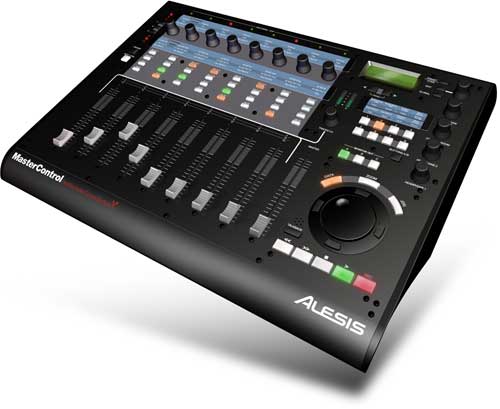
Winter NAMM Show: Alesis introduced their MasterControl Audio Interface and Control Surface.
The MasterControl is a professional audio interface and recording control surface, providing up to 44.1 – 192 kHz recording capability directly to your computer via ultra-fast, low latency FireWire connectivity. The audio interface features 2 mic (XLR) inputs with Phantom Power and channel inserts, 6 line (TRS) inputs, and boasts plenty of expansion capability; a total potential of 26 simultaneous inputs with the additional S/PDIF and dual S/MUX ADAT Lightpipe inputs (18 total digital inputs at 44.1/48 kHz or 10 at 88.2/96 kHz).
The outputs on the MasterControl feature six analog outputs, configurable as 5.1 Surround or three separate stereo outputs. With dedicated speaker switching, the MasterControl allows you to dynamically select between different monitor combinations to check your mixing references on different speakers.
In addition to being an audio interface, the MasterControl functions as a fully featured control surface for hands-on, dedicated control over your HUI-compatible DAWs and external MIDI devices. Each of the 8 channels strips is equipped with dedicated Solo, Record-Enable, Mute, and Select buttons for quick access to the most essential channel strip functions.
The jog wheel can be used to shuttle, zoom and enter data, and is complemented by a dedicated transport control section. The two banks of eight fully-assignable buttons provide different functions for setting markers, loop points and automation modes, while nine 100mm motorized faders and eight 360-degree virtual assignable knobs (three banks each allowing control over 24 different parameter), give you convenient control over your DAW’s parameters.
Removable, customizable templates provide a visual overview of all preset operations and all presets are fully editable and configurable.
Alesis say that the MasterControl is designed as a complete solution for all your recording and mixing needs and also features a built-in talkback microphone, a Preview button allowing you to preview knob, button and fader adjustments before sending them to your DAW, and full MIDI I/O interface.
In addition, the MasterControl comes bundled with Cubase LE and is compatible with most popular DAW software products on the market today.
Features
- 8 Built-in analog inputs – 2 XLR mic preamp inputs with Phantom Power and channel inserts, 6 TRS 1/4″ line inputs
- 192kHz analog recording / playback capability
- 6 analog outputs – configurable as discrete, 5.1 Surround, or Stereo X 3, with dedicated speaker switching
- Nine 100mm motorized faders and eight 360° virtual assignable knobs (three banks each) Provides instant access to 28 different parameters on every DAW channel
- 2 banks of 8 fully-assignable buttons provide 16 different functions per preset (setting markers and loop points, setting automation modes, cut/copy/paste)
- Expandable audio inputs for up to 26 simultaneous inputs. S/PDIF and dual S/MUX ADAT Lightpipe inputs provide 18 additional recording inputs
- 16 channels MIDI I/O
- 2 X 16 character LCD provides instant controller feedback and enables customization of knob and button functions
- Fully-editable presets allow for instantaneous, dedicated control over DAWs (HUI-compatible) and external MIDI devices
- Removable, customizable templates provide total visual overview of preset operation
- Preview button shows knob, button, and fader parameters before sending them out to DAW
- Built-in talk-back microphone and control-surface based cue mix setup
- Bundled with Cubase LE software and compatible with most digital audio workstation software products
Pricing and availability are TBA.

Hmmm… supports HUI DAW’s, but yet has a master fader. Master faders aren’t supported by HUI DAW’s. Has enough I/O, though. We’ll have to see how it pans out.
Matt
I had a chance to take a look at these at NAMM. The hardware itself looks very nice – nice layout, solid feeling controls and a good layout. No idea if it really works with anything yet, though.
The thought that came to mind when I saw this was that the audio interface/control surface was going to turn into a major category of computer music peripheral, because it just makes so much sense.